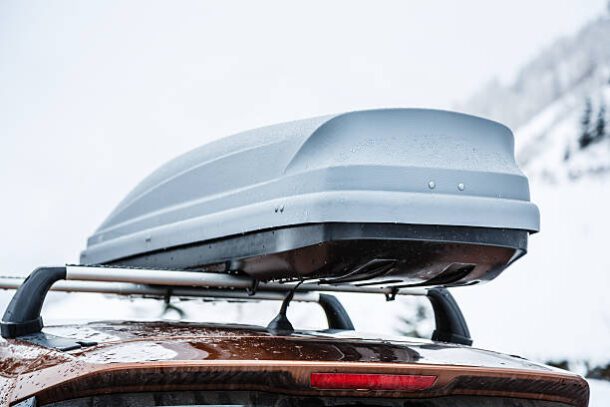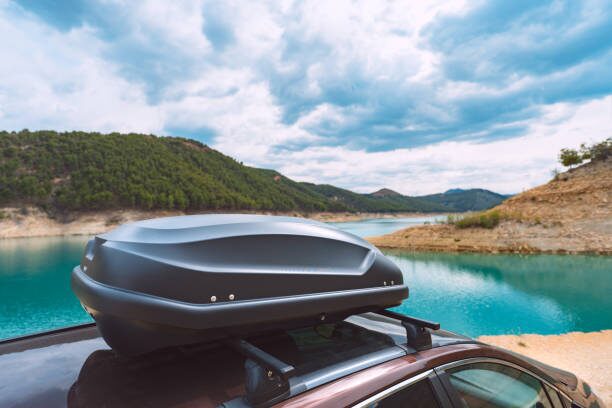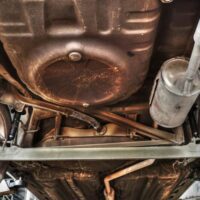Optimizing roof box positioning aerodynamics is crucial for minimising wind resistance and maintaining fuel efficiency during long drives.When it comes to travelling, particularly with a family, there’s frequently a parcel of baggage and adapts included.
A roof box is a well known solution to this issue, but did you know that where you position the box on your car can make a noteworthy distinction in its optimal design and fuel proficiency? The science of roof box positioning aerodynamics isn’t broadly known, but it can have a huge effect on your vehicle’s execution.
The Significance of Streamlined Features for Roof Boxes

When it comes to travelling with roof-mounted storage, numerous individuals centre exclusively on its capacity and comfort. In any case, one pivotal perspective that’s frequently ignored is the effect of optimal design on fuel effectiveness and, in general, execution.
Optimal design alludes to the thought about how objects move through the discussion and the strengths that act upon them. When a roof box is positioned aerodynamically, it disturbs the smooth stream of discussion, making it drag. This drag can increase fuel consumption, reduce soundness, and indeed produce wind clamour.
The Part of Roof Box Positioning Aerodynamically
When it comes to maximising effectiveness and progressing optimally, the positioning of your top storage container plays a vital role. Numerous individuals may not realise the effect that roof box positioning aerodynamics can have on their vehicle’s by and large streamlined execution.
The key principle, beyond any doubt, is that discussing resistance is the most important factor influencing a vehicle’s fuel productivity at high speeds. By decreasing the drag caused by the you’ll altogether improve the luggage carrier, your vehicle’s optimal design and, subsequently, its fuel effectiveness.
The Effect of Wind Resistance on Fuel Proficiency
When it comes to maximising productivity in your vehicle, understanding the effects of wind resistance is crucial. One range where wind resistance can essentially influence fuel effectiveness is when utilising a roof box positioning aerodynamism.
Whether you’re heading out on a family street trip or require additional capacity space for your open air enterprises, storage containers are a prevalent choice. Be that as it may, their situation on your vehicle can have a noteworthy effect on streamlined features and, hence, fuel consumption.
When a luggage carrier box positioning aerodynamics creates an extra surface region that is specifically interatomic with the disc as you drive. This included surface range, which increases the wind resistance your vehicle faces, resulting in a better drag constraint. The higher the drag constraint, the more control your vehicle must overcome, leading to expanded fuel utilisation.
Factors to Consider when A Roof Box Positioning Aerodynamics

When it comes to maximising the proficiency of your vehicle and moving forward streamlined features, the positioning of your roof-mounted storage plays a pivotal role. There are a few variables to consider when deciding on the ideal situation for packaging your cargo.
Weight conveyance is key. Setting the roof-mounted storage as far forward as possible can adversely affect the vehicle’s adjustment and care. On the other hand, positioning it as well as a distant back can affect the vehicle’s soundness. It is vital to discover the sweet spot where the weight is equally dispersed, guaranteeing ideal driving execution.
Ideal Roof Box Arrangement for Different Vehicle Sorts
Which top storage container fits my car? Well, when it comes to maximising proficiency and making strides in optimal design, the roof box positioning aerodynamics is a pivotal calculation to consider. The arrangement of the box on your vehicle can altogether affect its streamlined execution, affecting fuel efficiency and, in general, driving encounters.
For vehicles with a flat or curved luggage carrier, it is by and large prescribed to put the top cargo towards the front of the vehicle. This situation makes a difference in streamlining the wind over the vehicle, decreasing wind resistance and drag. By putting the top cargo closer to the front, you create a smoother wind current over the topline, permitting superior fuel proficiency and moving forward.
Tips for Decreasing Drag and Moving Forward Aerodynamics
When it comes to maximising effectiveness and moving forward optimal design, paying consideration to your roof box positioning aerodynamics is significant. Here are a few profitable tips to help you diminish drag and upgrade the streamlined execution of your vehicle.
Ideal Situation
The arrangement of your top cargo plays a critical role in reducing drag. To play down wind resistance, it is prescribed to position the box as far forward as conceivable on your vehicle’s luggage carrier. This situation permits for smoother wind current over the box, resulting in a more optimal design.
Streamlined Shape
Choosing a top cargo with a streamlined shape is basic for decreasing drag. Hunt for models that have a moo profile and are planned to play down wind resistance. These sleeker plans offer assistance in discussing the stream more easily around the storage container, lessening turbulence and drag.
Proper Mounting
Guaranteeing a secure and appropriate mounting of the top storage container is fundamental for optimal design. Make it beyond any doubt to take after the manufacturer’s enlightenment for establishment carefully. A tight and secure fit will avoid any unnecessary development or rattling, which can disturb the smooth wind stream over the vehicle.
Expel when Not in Use
In the event that you’re not using your top storage container routinely, consider evacuating it when not required. In spite of the fact that present day roofs are planned to play down drag, evacuating them when not in use encourages decreased wind resistance and increases fuel productivity.
Testing and Measuring the Impacts of Roof Box Positioning Aerodynamics
To genuinely maximise the proficiency of your top storage container and accomplish optimal design, it is significant to conduct testing and measure the impacts of diverse situations. This will permit you to discover the ideal arrangement that minimises wind resistance and improves fuel proficiency.
Begin by choosing a testing area with minimal wind obstructions, such as a wind burrow or an open street with controlled conditions. Guarantee that the vehicle utilised for testing is prepared with precise estimation instruments, such as anemometers and fuel consumption monitors.Other variables to consider for maximising effectiveness
Other Variables to Consider for Maximising Effectiveness

While roof box positioning aerodynamics may be a basic figure in maximising streamlined features, there are other variables to consider as well. These components can encourage upgrading the proficiency of your vehicle and optimise fuel utilisation.
Weight Dissemination
It’s fundamental to convey the weight of the interior of the cooftop cargo equitably. Uneven weight distribution can adversely affect the handling and soundness of your vehicle. Guarantee that heavier items are put towards the centre of the top storage container to preserve adjustment.
Streamlining Adornments
Separated from the cooftop cargo itself, other adornments like bike racks or kayak holders can add extra drag. Consider contributing to efficiently outlined embellishments that minimise wind resistance and move forward generally in productivity.
Speed and Driving Propensities
Whereas roof box positioning plays an imperative part in streamlined features, your driving propensities and speed too have a noteworthy effect. Driving at high speeds generates more wind resistance, diminishing fuel efficiency.
Support and Cleanliness
Keeping your vehicle and top-mounted storage carrier clean and well-maintained is significant for maximising effectiveness. Soil, tidy, and flotsam and jetsam on the top storage container’s surface can disturb wind streams and increase drag.
Real-World Illustrations and Victory Stories

Actualizing the science of roof-mounted storage situating for moved forward streamlined features has demonstrated to be exceedingly compelling in real-world scenarios. Various victory stories illustrate the critical effect it can have on maximising productivity and decreasing fuel consumption.
Conclusion
In conclusion, understanding the science of roof box positioning is pivotal in maximising efficiency and achieving superior fuel productivity. By following the standards discussed in this article, you’ll be able to essentially decrease the negative effect that top storage containers can have on your vehicle’s streamlined features.
Legitimate roof box positioning includes considering components such as the shape and estimate of the top storage container, the vehicle’s measurements, and the wind flow patterns. Placing the roof-mounted storage in the ideal position, more often than not towards the back of the vehicle and in line with the vehicle’s topline, minimises drag and turbulence.



